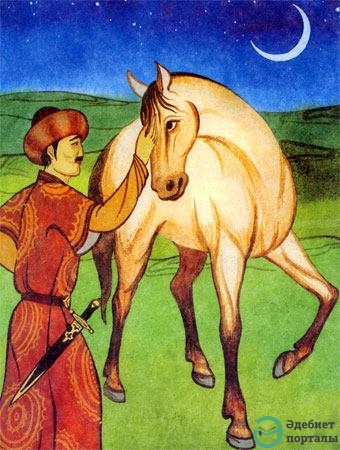The image of a winged horse in the oral literature
Share:
On the state emblem of the Republic of Kazakhstan, in addition to the main elements associated with the history and traditions of the people, Pegasus is designated. What relation do the winged horses of statehood have, what is the message in them?
From the description of the State Symbol it is said that the winged mythical horses - the Tulparas, are the key heraldic element. The image of the horse from time immemorial embodies such concepts as courage, loyalty and strength. Wings symbolize the centuries-old dream of the multinational people of Kazakhstan about building a strong and prosperous state. They testify to pure intentions and the desire for consistent improvement and creative development. The golden wings of horses also remind of golden ears and embody the diligence of the people of Kazakhstan and the material well-being of the country.
In ancient Greek mythology there is a bright character - Pegasus. Since the horse was born at the origins of the Ocean, it was called Pegasus (Greek "turbulent current"). He flew with the speed of the wind. According to legend, he had a stall in Corinth; Lived in the mountains, spending more time on Parnassus in Phocis and Helikon in Boeotia. Pegasus is actively involved in the subjects of ancient Greek mythology.


In the oral literature of the people mythological horses also have their place. For the people, winged horses are sacred. It is believed that the horse is a true friend of man in this world, also the horse accompanies him after death, in heaven. The Kazakh people led a nomadic way of life. For a strong-willed, a nomad, a warrior is an indispensable attribute. Therefore, many tales, epics, proverbs and sayings are related to the horse.
In the study, R.S. Lipets "Images of Batyr and His Horse in the Turkic-Mongolian Epic" notes the existence of an inseparable, almost mystical connection between the rider and his war horse, the importance for the batyr of an irreplaceable, intelligent, faithful and such a beautiful animal. In the cognitive book of O. Zhanaydarov ("Myths of Ancient Kazakhstan: Children's Encyclopedia of Kazakhstan" - Ed.) It is described that in the ancient epic the magic horse intended for the batyr, until he grows up, is among ordinary horses in the herd in the form of plain, thin and feeble A skate covered with ulcers and some dirty blanket. And when the batyr finally grows up, then his horse is transformed, showing his true appearance.
In the fairy tale "Kendebai on the horse Kerugula" there are lines where the whole power of the extraordinary Horse is described:
Kendebai-sal is me, what to conceal,
My faithful horse Kergul on the leash is not worth it,
The horse's mane fluttered to the gallop,
And the armor shines in the sun.

In the epic "Kobylandy batyr", the tulpar batyr is surprised by his pressure:
"... When he rushed forward,
Five hundred fathoms was his step.
Buryl jumped to the sky,
The sweat on his chest began to sweat.
Jumping, a quick horse jumps,
Stones fly out from under the hooves,
Like bullets from the guns of Kyzylbashs.
Easier than the skullcap seemed to him
Sitting on it a hero ... ".
In fairy tales "Kambar batyr", "Deldash batyr", "Padishah Abdirahman" also there are episodes of marvelous horses.
In the fairy tale "Shubarat" the fast horse Shubarat is described, which was faster than the wind: "Tired horses could not climb it. Having reached him, they stopped. And I had to lead them on about. Only Shubarat, stretched out like a string, flew to the top and became the winner. Since then, the mountain has come to be called Shubarat. " In the tale "Telconur" it is said about an incredibly beautiful horse. If the music played, the horse galloped gracefully under it. It also describes the incredible speed of the horse: "Telconur rushed from the rider to the side and rushed to the waves of Zhaiyk. Nobody had time to gasp as the horse was already shaking off the water on the other side. " And in the fairy tale "Matchmaking of Edile and Zhayik" the image of the winged horse is very clearly described. "And she saw that the horse was not simple, but magic, winged: he kept his wings in troughs, one in water, the other in milk, after cooling them" .
In the oral folk art images of miracle horses are often found. This indicates the importance of the horse for the Kazakh people. Across the territory of Kazakhstan there are hills and mountains, lakes and rivers, jailau and plains, named after the legendary tulpars - the true spirits of the Great Steppe.
Translated by Akhan Tuleshov,
Author: Aliya Kemelbekova
adebiportal.kz - Literary Portal
Share: